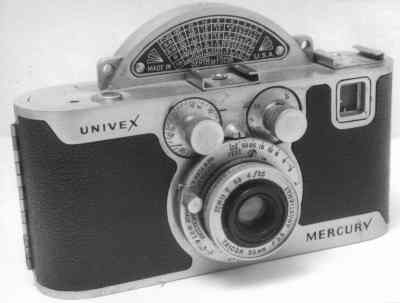
Universal Univex Mercury Model CC
Sometimes called the Mercury CC, because it says "Model CC" on the back,
the Univex Mercury was a very early American venture into the new (at the
time) world of 35mm still cameras. It first appeared in 1938, and has
some unique features at an amazingly low price. It is an odd-looking,
but strangely attractive, camera due to the rotary shutter (in some
ways like the shutter on the later Olympus Pen F cameras), which required
a large hemisphere on the top of the camera. The lens and twin dials
on the top (one cocks the shutter, the other sets the shutter speeds)
give the camera an attractive Mickey-Mouse appearance. But if
you imagine the top "chopped-off", the Mercury does not look that different
from other 35mm cameras of the time, such as the Leica. It came with
a choice of three 35mm focusing lenses (equivalent to a 50mm in the full-frame
format) -- one was an f2.0, another was f 3.5, and the most common was
an f2.7 - 22. Speeds of T, B, 1/20 - 1/1000. Close-focusing to
1.5 feet. It had two "flash" shoes which were used for its many
accessories. One was actually the first hot shoe -- which only worked
with the Universal flash for the camera. The other shoe could be used
with an accessory viewfinder/flash shoe. The camera lens has an
interchangeable mount (somewhere around 15/16"), so other, longer focal length
lenses could be used -- and some were made, such as a 75mm and 135mm. The
two flash shoes could also be used at the same time to hold an accessory
rangefinder. Filters, a macro extension tube, and a quick film-advance
lever were also available as accessories. A tripod socket and cable
release connection were built-in. Sounds pretty versatile for today,
let alone 1938. There is a special exposure guide on the camera back,
and depth-of-field calculator on the front of the hemisphere. Unusual parallax
marks in the viewfinder. It was a large camera by today's standards,
but very convenient -- and small -- at the time. Some sources
report that it used special cassettes. It did not. It used regular,
perforated 35mm film on special reels -- similar to 35mm cassettes,
but without the cover. So if you want to use it, you have to have a
pair of these reels and load them yourself. The loading must take place
in the dark, so you cannot change film outside of the darkroom. The
exposure counter only runs to 36 so longer rolls cannot be conveniently used.
The camera sold quite well at the time, but the onset of World War
II soon brought a demise to camera sales and production. Heil Hitler.
COPYRIGHT @ 1995-2017 by Joe McGloin. All
Rights Reserved.

